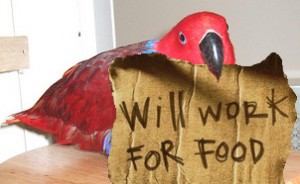Wild birds spend the majority of their day foraging for food. In captivity, birds are most often presented with food in a bowl. A captive bird only spends about 15 to 30 minutes per day eating. Therefore, captive birds are often bored which can lead to the development of behavioural problems such as feather plucking, self mutilation, destructiveness and screaming. To prevent the development of behavioural problems we recommend the introduction of captive foraging to your bird’s daily routine.
Captive foraging is the offering of food in such a way that your bird has to actively find its food and develop methods for obtaining access to that food source. Initially, the foraging methods used should be easy so your bird has time to adapt to the novel methods of providing its food. More complex techniques can be introduced to your bird when it becomes more curious.
There are a variety of foraging techniques that can be used. A few examples are provided below:
- Hiding – involves placing a small amount of food in a food bowl and mixing or burying it with paper kitty litter, wood shavings, shredded paper or another appropriate material.
- Wrapping –involves wrapping food inside something that is safe for the bird (e.g. butchers paper, used envelopes) and closing the ends by twisting or using tape.
- Covering – involves covering your bird’s food bowl with paper so your bird has to remove it to get to its food. When your bird has adjusted to this technique, the level of complexity can be increased by taping the paper to the bowl.
- Commercially available toys – there are a variety of commercially available toys that can be used for foraging including baffle cages, piñatas, puzzles and kabobs.
- Homemade toys – Toys can be constructed from basic materials like wood, leather and paper. The types of toys that can be constructed are limited only by your imagination.


No comments:
Post a Comment